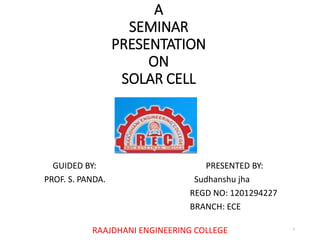
solar cell
- 1. A SEMINAR PRESENTATION ON SOLAR CELL GUIDED BY: PRESENTED BY: PROF. S. PANDA. Sudhanshu jha REGD NO: 1201294227 BRANCH: ECE RAAJDHANI ENGINEERING COLLEGE 1
- 2. INTRODUCTION • Introduction • History • Working Principle • Types of Solar Cells • Benefits • Application • Disadvantage 2
- 3. What is SOLAR CELL..? •A SOLAR CELL is a solid state electrical device that converts energy of light directly into electricity by Photoelectric Effect. •A SOLAR CELL is also known as Photovoltaic Cell or Photoelectric Cell. 3
- 4. HISTORY OF SOLAR CELL.. • The term “Photo” comes from the Greek meaning “light”, and “voltaic”, from the name of the Italian physicist “Volta”. • The PHOTOELECTRIC EFEECT was first recognized in 1839 by French physicist A.E. BECQUEREL. • ALBERT EINSTEIN explained the photoelectric effect in 1905 for which he received the Nobel prize in Physics in 1921. • The highly efficient solar cell was first developed by DARYL CHAPIN, CALVIN SOUTHER FULLER and GERALD PEARSON in 1954 using a diffused silicon p-n junction. • Solar Cells were first used in Vanguard I satellite, launched in 1958 4
- 5. HOW IT WORKS..? • Photovoltaic cells are made of special materials called semiconductors such as silicon. • An atom of silicon has 14 electrons. • we use phosphorus(with 5 electron Therefore when it combines with silicon, one electron remains free. 5
- 7. 7 continue…… •When energy is added to pure silicon free carriers are generated. • These free carriers, which move randomly in structure . • when impure silicon release one extra item. As a result, we have a lot more free carriers than we would have in pure silicon to become N-type silicon.
- 8. 8 continue…. • The other part of a solar cell is doped with the element boron(with 3 electrons in its outer shell)to become P-type silicon. • Now, when this two type of silicon interact, an electric field forms at the junction which prevents more electrons to move to P-side. • When photon hits solar cell, its energy breaks apart electron-hole pairs. Each photon with enough energy will normally free exactly one electron, resulting in a free hole as well. If this happens close enough to the electric field, this causes disruption of electrical neutrality, and if we provide an external current path, electrons will flow through the P side to unite with holes that the electric field sent there, doing work for us along the way. The electron flow provides the current, and the cell's electric field causes a voltage. • Now to protect the solar cell, we use antireflective coating to reduce the losses and then a glass plate to protect the cell from elements
- 9. 9
- 10. ADVANTAGE • The very first benefit of using this technology is that solar energy is renewable. • This is a 100% environment-friendly. • Contrary to fossil fuels, this technology is not going to release any greenhouse gases, harmful agents, volatile material or carbon dioxide into the environment. • Solar panels are highly durable and reliable. These systems don’t have any moving systems and hence they don’t require any replacement. 10
- 11. DISADVANTAGES.. •The main disadvantage of solar cell is the initial cost. Most types of solar cell require large areas of land to achieve average efficiency. •Air pollution and weather can also have a large effect on the efficiency of the cells. •The silicon used is also very expensive and the solar cells can only ever generate electricity during the daytime. 11
- 12. 12 APPLICATION.. • Rural electrification: The provision of electricity to rural areas derives important social and economic benefits to remote communities throughout the world like power supply to remote houses, electrification of the health care facilities, irrigation and water supply and treatment. • Ocean navigation aids: Many lighthouses are now powered by solar cells. • Telecommunication systems: radio transceivers on mountain tops are often solar powered. • Photovoltaic solar generators have been and will remain the best choice for providing electrical power to satellites in an orbit around the Earth.
- 13. • Another con to Solar cell technology is that the efficiency level of this technology is low. • The most efficient solar power system gives you an efficiency of not more than 40%. This means that the rest of the 60% power of sunlight is not harnessed. • The most important thing that is necessary is the sky should be clear so that sunlight can fall on the solar cell and we can get electricity. 13
- 14. CONCLUISION • Argument that sun provides power only during the day is countered by the fact that 70% of energy demand is during daytime hours. At night, traditional methods can be used to generate the electricity. • Goal is to decrease our dependence on fossil fuels. • Solar cell light absorbing materials can be stacked to take advantage of different light absorption and charge separation mechanisms 14
- 15. REFRENCE • www.solarcell.net.in • www.wikipedia.org • www.google.com • “Quantum Mechanics” by A.K Ghatak and S Lokanathan. • www.worldscibooks.com/physics/p276.html 15